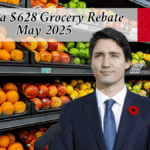The Climate Action Incentive Payment (CAIP) is a quarterly rebate program designed to help Canadians manage the added costs brought about by the federal carbon pricing system. Introduced as a way to support households and encourage environmentally responsible practices, the CAIP provides financial relief directly to individuals and families—especially those impacted by fuel charges.
As of June 2025, the CAIP continues to be a cornerstone of Canada’s climate policy. The rebate varies by province and is based on factors such as household size, residency, and location (urban vs. rural). This comprehensive guide explains who qualifies, how much you could receive, and what changes have been made to the 2025 structure.

Quick Summary Table
| Topic | Details |
|---|---|
| Program Name | Climate Action Incentive Payment (CAIP) |
| Payment Date | June 2025 |
| Eligibility | Filed 2024 taxes, 19+ years, reside in eligible provinces |
| Delivery Method | Direct deposit (or mailed cheque by CRA) |
| Rural Supplement | 10% additional if residing outside major urban centres |
| Frequency | Quarterly (January, April, July, October) |
| Taxable Income | No, CAIP is non-taxable |
| Official Website | https://www.canada.ca/en/revenue-agency/services/child-family-benefits/cai-payment-amounts.html |
June 2025 Climate Action Incentive Payment Amounts by Province
Below is a province-by-province breakdown for a single adult. Additional household members (spouse or children) receive smaller add-on amounts. A 10% rural supplement is also provided for those living outside metropolitan regions.
| Province | Base Amount (Single Adult) | Additional Adult | Per Child | Rural Supplement | Delivery |
|---|---|---|---|---|---|
| Alberta | $225 | $112.50 | $56.25 | 10% | Direct Deposit |
| Saskatchewan | $195 | $97.50 | $48.75 | 10% | Direct Deposit |
| Manitoba | $170 | $85.00 | $42.50 | 10% | Direct Deposit |
| Ontario | $140 | $70.00 | $35.00 | 10% | Direct Deposit |
| New Brunswick | $110 | $55.00 | $27.50 | 10% | Direct Deposit |
| Nova Scotia | $105 | $52.50 | $26.25 | 10% | Direct Deposit |
| Prince Edward Island | $95 | $47.50 | $23.75 | 10% | Direct Deposit |
| Newfoundland | $100 | $50.00 | $25.00 | 10% | Direct Deposit |
Key Changes in 2025 CAIP Payment Structure
Several updates have been made to the CAIP for 2025:
-
Quarterly Distribution: Previously issued as an annual tax credit, CAIP is now paid out every three months to provide more immediate support.
-
Automatic Rural Supplement: A 10% supplement is added for those living in rural areas to acknowledge increased heating and transportation costs.
-
No Application Necessary: If you’re eligible and filed taxes on time, the payment is automatic through the Canada Revenue Agency (CRA).
Who Qualifies for the June 2025 Carbon Rebate?
To receive the CAIP payment for June 2025, you must:
-
Have filed your 2024 income tax return by spring 2025.
-
Be at least 19 years old, or meet other CRA eligibility exceptions.
-
Reside in a province subject to the federal carbon pricing system.
No further action is needed. However, to ensure accurate payments, it is crucial that your household information (number of dependents, spouse) is correctly reported on your tax return.
CAIP vs. GST/HST Rebate: Understanding the Difference
Although both are CRA-administered benefits, the CAIP and GST/HST rebate serve different purposes:
| Feature | CAIP | GST/HST Rebate |
|---|---|---|
| Purpose | Offset costs from carbon pricing | Offset federal sales taxes |
| Payment Frequency | Quarterly | Quarterly |
| Income-Tested | Yes | Yes |
| Family-Based | Yes | Yes |
| Taxable? | No | No |
Households often receive both rebates but for distinct reasons. Budget planning should take both into account.
How the Carbon Rebate Supports Climate Policy
Canada’s carbon pricing system is meant to encourage environmentally responsible behavior by making greenhouse gas-producing fuels more expensive. However, this could strain household finances—especially for those in colder climates or rural areas.
The CAIP aims to mitigate that burden, returning most of the carbon pricing revenues to households. The underlying goal is to influence energy consumption without causing undue financial hardship.
This also encourages long-term investment in energy-efficient home upgrades, low-emission vehicles, and greener lifestyles—a key strategy in Canada’s climate roadmap.
Frequently Asked Questions (FAQs)
1. What is the carbon rebate amount for a family of four in Alberta?
A family with two adults and two children in Alberta will receive:
-
$225 (first adult)
-
$112.50 (second adult)
-
$56.25 x 2 (for two children)
Total: $450, plus a 10% rural supplement if applicable.
2. How do I know if I qualify for the Climate Action Incentive Payment?
You qualify if you:
-
Filed your 2024 income tax return
-
Are 19 years or older
-
Live in a province where the federal fuel charge applies
If these criteria are met, payments are issued automatically via CRA.
3. Is the carbon rebate taxable income?
No. The CAIP is non-taxable and does not reduce or affect any other federal benefits you receive.
4. When is the next CAIP payment scheduled?
The next CAIP payment is expected in October 2025. Payments occur quarterly in January, April, July, and October.
5. What if I didn’t receive my CAIP payment in June 2025?
If you didn’t receive your payment:
-
Log into your CRA My Account
-
Verify your direct deposit information
-
Check if your 2024 taxes were filed on time
If issues persist, contact CRA support for assistance.
If you need more guidance or to check your personal rebate status, visit the official CRA page here:
Canada.ca – Climate Action Incentive Payment.
Conclusion
The June 2025 Climate Action Incentive Payment reflects Canada’s commitment to balancing climate responsibility with economic fairness. By offering substantial rebates—especially for rural residents and larger families—the federal government ensures that the carbon pricing system does not disproportionately impact vulnerable households.
Staying informed about how the CAIP works, how much you’re entitled to receive, and when it arrives can help you make better financial and energy decisions. The system may evolve, but its dual goal—environmental action with financial equity—remains constant.
Click here to know more



